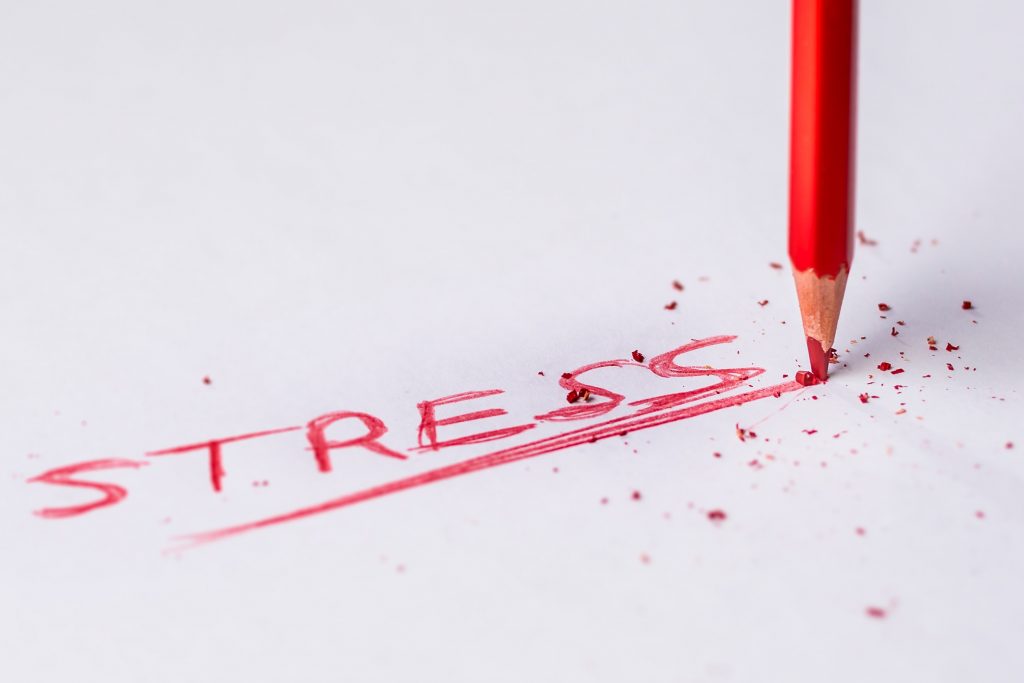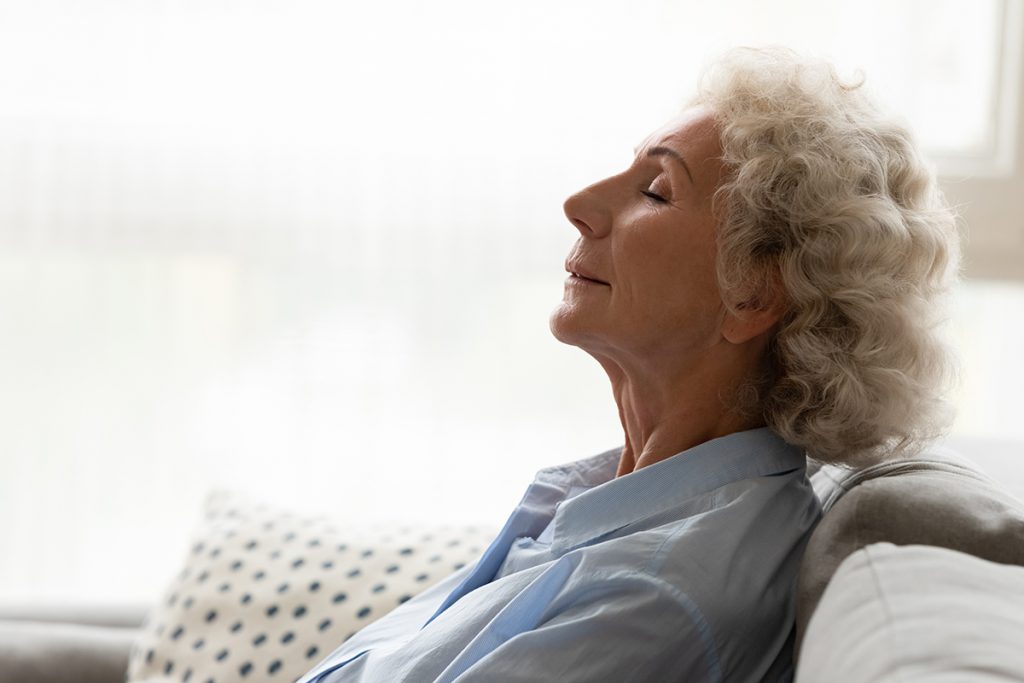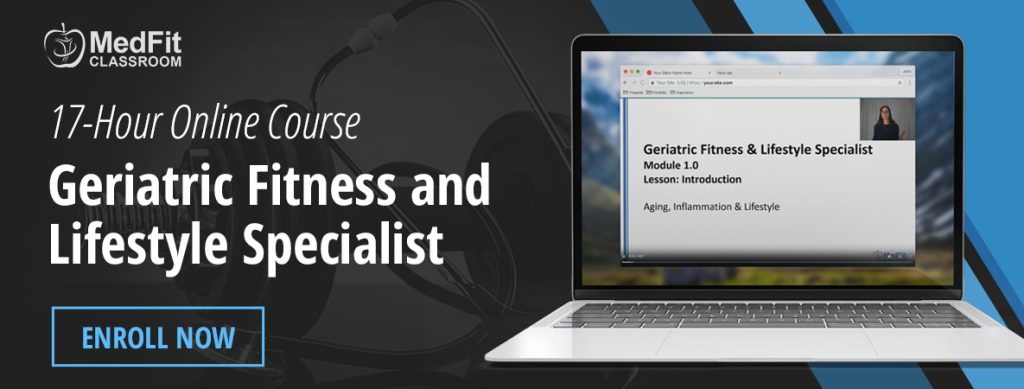We can all agree that stress levels have skyrocketed to an all-time high following the “year of fear.” Older adults with chronic conditions have been the hardest hit since they are most vulnerable to Sars-CoV-2 and severe outcomes. Millions have been struggling with the fear of infection and mortality; inactivity and muscle weakness as well as social distancing and isolation. Helping older adults build stress resilience strategies into daily life is critical to bolster and protect physical, mental and social wellbeing.

Living under chronic stress leads to bad decisions. That’s because the part of the brain called the amygdala is activated when under threat. It is our survival brain with the “fight or flight” response being its signature. This means that blood is flowing to the “reactive” brain and away from the “thinking and planning” part of our brain, the pre-frontal cortex.
This can contribute to poor eating, activity and lifestyle choices. Convenience and processed foods can easily take center stage along with sedentary behaviors and heavier use of drugs and alcohol. This can lead to malnutrition, decreased blood flow and the increased risk and severity of chronic conditions as well as impairing immune function. It is a recipe for dis-ease and higher health risks, particularly in pandemic times.
Chronic stress puts the body into a catabolic state of “breaking down” while also turning down the volume on the body’s anabolic pathways of “building up” (1). The body was designed to live in the parasympathetic state, also known as “rest, digest, heal and repair” mode. Constantly living in the stress response leads to high levels of cortisol, oxidative stress and pro-inflammatory cytokines (immune messengers). This chemical marinade literally shrinks muscle and brain cells (2).
Chronic Stress Stinks & Shrinks
What happens when muscle and brain cells atrophy? Sarcopenia and cognitive decline arrive on the scene. This in turn leads to the downward spiral of physical and mental pathology that can include disability, dependency, dementia, an increased risk of falls, fractures and hospitalizations.
Resilience is a Process
The American Psychological Association defines resilience as “the process of adapting well in the face of adversity, trauma, tragedy, threats, or significant sources of stress,” or “bouncing back” from difficult experiences (3). It is an adaptive process that can be developed. Being “hardy” or resilient is linked with positive outcomes, including improved functional mobility, health and longevity.
Medical fitness specialists can help older adults build stress resilience by empowering them with education and encouragement. This can be a powerful intervention as it combines education with behavior modification. It includes asking questions while providing clear messaging that reduce fears and clarify health benefits followed by simple actionable steps. The pro-active older adult can choose to practice the strategies that resonate with them. Being accountable to and encouraged by a trainer knowledgeable about geriatrics can support the process of building resilience to weather “stress storms.”
Building Stress Resilience
Like health, resilience is multi-dimensional and includes physical, mental and social components. As fitness professionals, we understand that exercise activity is the most powerful intervention to relieve stress because movement positively impacts the health of every cell in the body and brain. After all, who doesn’t feel better after an appropriate workout or walk in the sunshine?!
5 Simple Strategies
Being mindful of breathing, eating and moving are great ways to build stress resilience. Living in the present moment helps develop awareness, connection and calm. Avoid overwhelm by choosing to practice one small step at a time.

1. Breathe Deeply. Breath connects body and mind. Stress breathing is shallow breathing. By focusing on the depth and pace of breath, the parasympathetic nervous system is engaged. Encourage older adults to become aware of tension and overwhelm; to take “Breathing Breaks” while focusing on breathing in and out through the nose. It can be as simple as starting with 3 deep breaths and working up to 30.
2. Eat Slowly. In order to digest food and absorb nutrients properly, eat seated in a relaxed, calm environment. Encourage older adults to slow down and focus on chewing food 20-30 times. This supports the mechanical breakdown of food for better digestion. While eating, focus on the food’s aroma, flavor, texture, mouth feel and swallowing.
3. Tea Time. Take a few minutes to savor a warm cup of herbal tea like lemon balm, lavender or chamomile. Enjoy the aroma and feeling of warmth in hand and the body. This practice is a wonderful way to wind down at the end of the day or as needed.
4. Gratitude Attitude. Before rising and/or going to bed, think about, say out loud or write down 3 things you are grateful for. Practicing gratitude is linked with boosting happiness, optimism and a sense of greater well-being (3).
5. Move more. Inactivity and sedentary time slows down blood flow, metabolism and immune function. Encourage older adults to break up sedentary time with 5 minutes of movement every hour. Light intensity activity like house cleaning has been shown to reduce the risk of mobility disability by 40%! Simply moving more throughout the day is powerful medicine, especially when paired with a tailored exercise program.
Today, building stress resilience is absolutely critical for older adult’s functional and cognitive health. They will be so grateful for your guidance!
Fit Pros: Guide Older Clients as a Geriatric Fitness and Lifestyle Specialist
Millions of people over age 65 looking for guidance from fitness professionals who are knowledgeable in exercise, nutrition and lifestyle principles that can help them improve functional mobility, while also preventing and managing chronic conditions to live their highest quality of life. The Geriatric Fitness and Lifestyle Specialist online certificate course will give you insights, strategies and tools to be a successful professional in this rapidly growing market. Learn how to be a valued part of clients’ continuum of care, working with the medical team to improve functional outcomes and positively impact people’s lives.

Cate Reade, MS, RD is a Registered Dietitian, Exercise Physiologist and Functional Medicine Practitioner candidate on a mission to improve functional mobility and health span utilizing the power of lifestyle medicine. She has been teaching, writing and prescribing healthy eating and exercise programs for over 25 years. Today, as CEO of Resistance Dynamics and inventor of the MoveMor™ Mobility Trainer, she develops exercise products and programs that target joint flexibility, strength and balance deficits to help older adults fall less and live more.
References
- Kirwan R et al (2020). Sarcopenia during COVID-19 lockdown restrictions: long-term health effects of short-term muscle loss. Geroscience. https://www.ncbi.nlm.nih.gov/pmc/articles/PMC7528158/
- Mohammed A & Kunugi H (2021). Screening for Sarcopenia (Physical Frailty) in the COVID-19 Era. Int J Endocrinol. https://www.ncbi.nlm.nih.gov/pmc/articles/PMC8152925/
- MacLeod, S et al (2016). The impact of resilience among older adults. https://www.sciencedirect.com/science/article/pii/S0197457216000689
